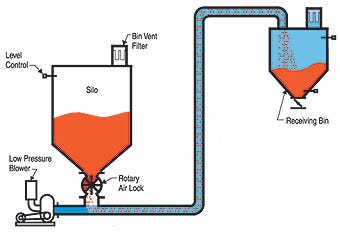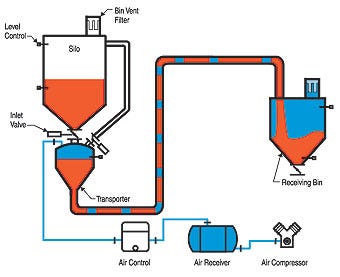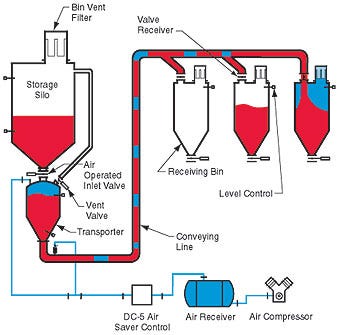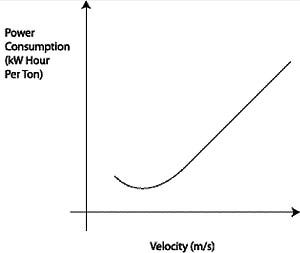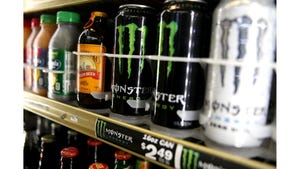Dense-Phase Pneumatic Conveying Systems 71
January 11, 2007
|
Figure 1: Dilute-phase conveying system |
Pneumatic conveying is achieved by creating a pressure differential along a pipeline and using the air that moves toward the area of lower pressure to move bulk material. This process can be performed with a vacuum inducer or by injecting compressed air into one end of a pipeline or along the pipeline.
Dilute-Phase versus Dense-Phase Pneumatic Conveying
The two main categories of pneumatic conveying technologies are low-pressure (dilute-phase) and high-pressure (dense-phase) systems. Utilizing air pressure under 15 psig, the first category uses either positive or negative pressure to push or pull material through the convey line at relatively high velocities (see Figure 1). It is a low-pressure, high-velocity system because it has a high air-to-material ratio.
The second category utilizes air pressures above 15 psig. This system uses positive pressure to push materials through the convey line at relatively low velocities (see Figure 2). It is a high-pressure, low-velocity system because it has a low air-to-material ratio.
Why Dense Phase?
Dense-phase pneumatic conveying uses a small amount of air to move a large amount of bulk material in closely associated slugs through a convey line, much like extruding. Unlike dilute-phase conveying systems, which typically use larger amounts of air to move relatively small amounts of material at high velocities in suspension, dense-phase systems offer the advantage of efficiently pushing a much denser concentration of bulk solids at relatively low velocities through a convey line.
|
Figure 2: Dense-phase conveying system |
Pneumatic Conveying Systems for Bulk Materials
Many material-handling plants transfer large quantities of materials, often over long distances. As a result, the conveying system’s power consumption is of prime importance. In pneumatic conveying, power consumption is a function of the system design, transfer rate, and convey length. Therefore, a conveying system that transfers 100 tn/hr of a bulk material over a distance of 200 m uses about the same amount of power as a system of the same design that conveys 200 tn/hr of the same material over a distance of 100 m. Consequently, it is evident that the length of a pneumatic conveying system has the same impact on power consumption as does rate.
Traditionally, bulk materials have been conveyed by inefficient pneumatic conveying systems. However, modern material-handling plants require more-efficient conveying systems to reduce power costs. In addition to reducing electricity costs, lowering power consumption offers many other benefits. First, conveying systems that use less power require less maintenance. Compare a Formula 1 racecar to an economy car. Which car requires more maintenance? Which car gets more life from the tires? Which car gets more life from the engine? Pneumatic conveying systems are no different. If two pneumatic conveying systems must convey the same material over the same distance and one system uses less power than the other, the system that consumes less power will experience less wear, require a smaller dust filter, and reduce pollution.
Recent Developments in Dense-Phase Pneumatic Conveying Systems
As shown in Figure 3, the dense-phase Full Line Concept conveying system features DC-5 Air Saver technology, a method in which small amounts of compressed air are automatically injected along the convey pipe in response to internal pipe conditions. This technology reduces air consumption to the absolute minimum, allowing the pipeline to convey material at maximum density. In contrast to a vacuum cleaner, the convey pipe contains as much material-e.g., cement-and as little air as possible.
The Full Line Concept system has a series of air inlet devices, called DC-5 Air Saver controls, that are mounted on the convey line. Each control enables some convey air to enter the convey line. The controls regulate the convey velocity and prevent system plugging. In effect, the controls reduce the total resistance of the system. The effect they control provides an incremental force. The total number of controls acting in unison produces a significant total force.
|
Figure 3: Full Line Concept conveying system with |
Material fills the transporter from a storage silo through an inflatable seated butterfly valve. Displaced air is sent through a vent valve to allow easier filling. Once the transporter is filled, as signaled by a high-level control or weighing device, the inlet and vent valves close and seal. Then the outlet valve opens and compressed air is introduced into the transporter to displace the conveyed material. The rest of the air for conveying is added using the controls along the convey line.
When the transporter is completely empty, as signaled by a low-level control in the transporter, the compressed air is turned off and material stops in the convey line. Because the line does not have to purge itself, the high velocity normally used in conventional systems during purging is eliminated, making the system ideal for abrasive or fragile materials.
In addition, since the line always remains full, no time is lost in emptying and filling the convey line. Air consumption is drastically reduced, making the system ideal for long convey lines and for systems in which a single type of material is conveyed. However, the unit can also operate as a conventional system when the convey line must be purged during maintenance or when product changeovers occur.
Advantages of Pneumatic Dense-Phase Conveying Systems
The maximum-density convey technique has three main advantages. First, because the convey pipeline is packed densely with bulk material, air cannot “slip” past the material, a common source of inefficiency in pneumatic conveying systems. If the slip is eliminated, efficiency improves. Second, when the convey pipe is filled to the maximum, only a small percentage of particles maintain contact with the convey pipe at any given time. Most particles remain in the pipe’s interior, reducing pipe abrasion and wear. Third, by increasing material density in the pipe, convey velocity can be decreased for a given transfer rate and pipe diameter. The transfer rate, Q in kg/sec, can be expressed as Q = bAv. where b = the conveying density in kg/m³, A = the conveying pipe area in m², and v = the conveying velocity in m/sec. Rearranged, the formula reads:

Therefore, if the convey density is increased while all other variables remain constant, the convey velocity decreases.
Velocity control is another advantage of the technology. Because compressed air is injected along the convey pipe, the DC-5 Air Saver can provide accurate control of the convey velocity. This is important for three reasons.
First, as in automobiles, energy efficiency in a pneumatic conveying system is velocity dependent. In general, the slower the convey velocity, the better the air efficiency (see Figure 4). Second, pipe wear increases with velocity and is proportional to the velocity cubed. Hence, a twofold increase in velocity results in an eightfold increase in wear. Even small reductions in velocity can reduce pipe wear dramatically. Third, a slower convey velocity reduces the chance of pipe plugging.
|
Figure 4: Air efficiency versus conveying velocity |
This relationship is perhaps counterintuitive: After all, wouldn’t drivers speed up their vehicles to avoid getting stuck in the mud? The opposite is true of pneumatic conveying systems, for such systems must change directions through the use of pipe bends. When conveyed material reaches a bend in a pipe, friction at the bend causes it to decelerate. If the material moves too fast when it approaches the bend, it decelerates too rapidly, causing the conveyed material to compact like a brick and form a plug. However, if the convey velocity is very slow, the deceleration is negligible. While a racecar driver must brake hard at every turn, a bicyclist would hardly notice the turns, since bicycles move relatively slowly. Achieving that slow effect is the goal of pneumatic conveying systems.
Improved Reliability
The DC-5 Air Saver technology provides another significant benefit: reliability. Because compressed air is injected along the convey pipeline, the system automatically adjusts the compressed air distribution to break plugs when they occur. The system automatically reacts to the convey conditions and can provide tremendous leverage to dislodge a blockage at any point along the pipe. A robust system can convey less-than-ideal materials.
Conclusion
Since modern material-handling facilities have become more concerned with energy efficiency and conveying-system reliability, they require more-advanced conveying systems to reduce their operating costs. Therefore, a supplier of pneumatic conveying systems must provide a high-tech solution to move material reliably using a minimal amount of compressed air. Although slightly more expensive in the short run, such a system pays for the advanced technology in just a few years by reducing operating costs in the long run.
Gregory J. Steele, PE, is executive vice president of Dynamic Air Inc., St. Paul, MN, a leader in the dense-phase pneumatic conveying industry and a specialist in the pneumatic conveying of dry bulk solids. He can be reached at 651-486-3023 or [email protected].
About the Author(s)
You May Also Like

